Implementing and Managing Change in Health and Social Care: A Report
VerifiedAdded on 2023/01/13
|12
|4018
|99
Report
AI Summary
This report provides a comprehensive analysis of change management within the health and social care sector. It begins by identifying the key internal and external factors that drive change, including political, legal, demographic, and technological influences, and assesses the challenges these factors present, such as funding, legislation, and workforce issues. The report then proposes strategies and criteria for measuring the impact of recent changes, including inspections, feedback mechanisms, and system quality assurance, evaluating the overall impact on service users, staff, and organizations. Furthermore, it suggests appropriate service responses to these changes and concludes with an examination of the key principles of change management and how changes are planned and monitored within health and social care services. The report emphasizes the importance of adapting to evolving needs, meeting service quality standards, and ensuring stakeholder support to facilitate effective change management.
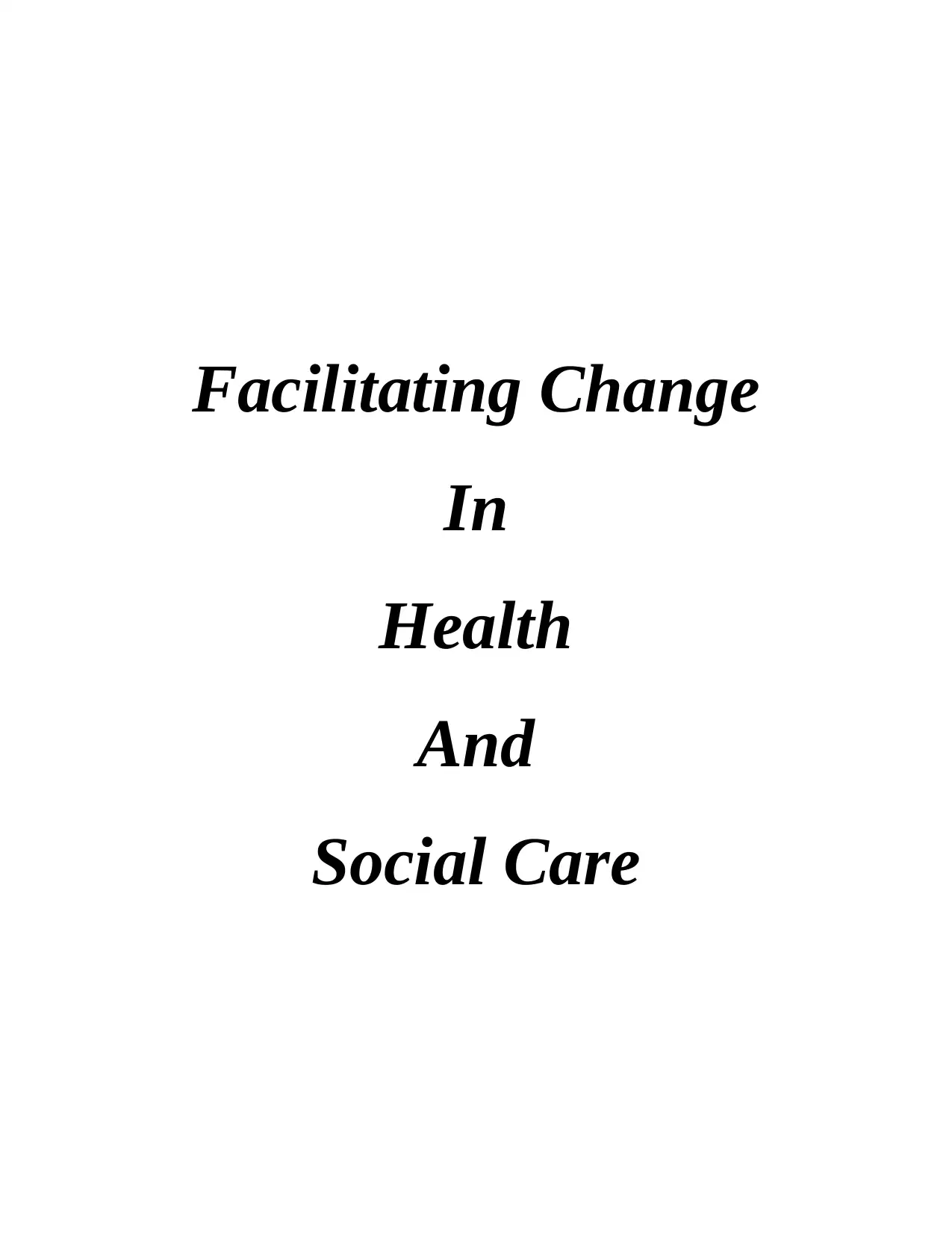
Facilitating Change
In
Health
And
Social Care
In
Health
And
Social Care
Paraphrase This Document
Need a fresh take? Get an instant paraphrase of this document with our AI Paraphraser
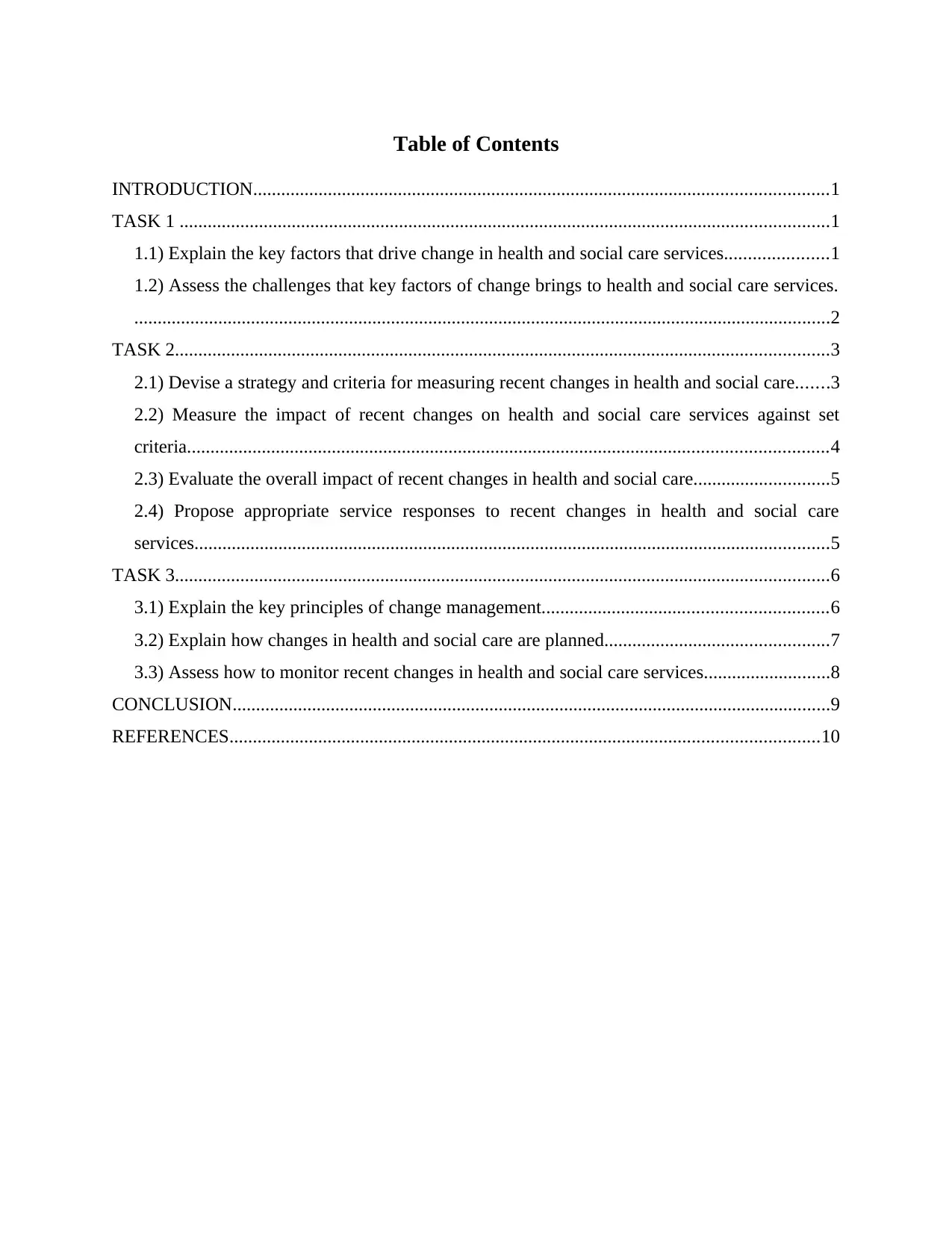
Table of Contents
INTRODUCTION...........................................................................................................................1
TASK 1 ...........................................................................................................................................1
1.1) Explain the key factors that drive change in health and social care services......................1
1.2) Assess the challenges that key factors of change brings to health and social care services.
.....................................................................................................................................................2
TASK 2............................................................................................................................................3
2.1) Devise a strategy and criteria for measuring recent changes in health and social care.......3
2.2) Measure the impact of recent changes on health and social care services against set
criteria.........................................................................................................................................4
2.3) Evaluate the overall impact of recent changes in health and social care.............................5
2.4) Propose appropriate service responses to recent changes in health and social care
services........................................................................................................................................5
TASK 3............................................................................................................................................6
3.1) Explain the key principles of change management.............................................................6
3.2) Explain how changes in health and social care are planned................................................7
3.3) Assess how to monitor recent changes in health and social care services...........................8
CONCLUSION................................................................................................................................9
REFERENCES..............................................................................................................................10
INTRODUCTION...........................................................................................................................1
TASK 1 ...........................................................................................................................................1
1.1) Explain the key factors that drive change in health and social care services......................1
1.2) Assess the challenges that key factors of change brings to health and social care services.
.....................................................................................................................................................2
TASK 2............................................................................................................................................3
2.1) Devise a strategy and criteria for measuring recent changes in health and social care.......3
2.2) Measure the impact of recent changes on health and social care services against set
criteria.........................................................................................................................................4
2.3) Evaluate the overall impact of recent changes in health and social care.............................5
2.4) Propose appropriate service responses to recent changes in health and social care
services........................................................................................................................................5
TASK 3............................................................................................................................................6
3.1) Explain the key principles of change management.............................................................6
3.2) Explain how changes in health and social care are planned................................................7
3.3) Assess how to monitor recent changes in health and social care services...........................8
CONCLUSION................................................................................................................................9
REFERENCES..............................................................................................................................10
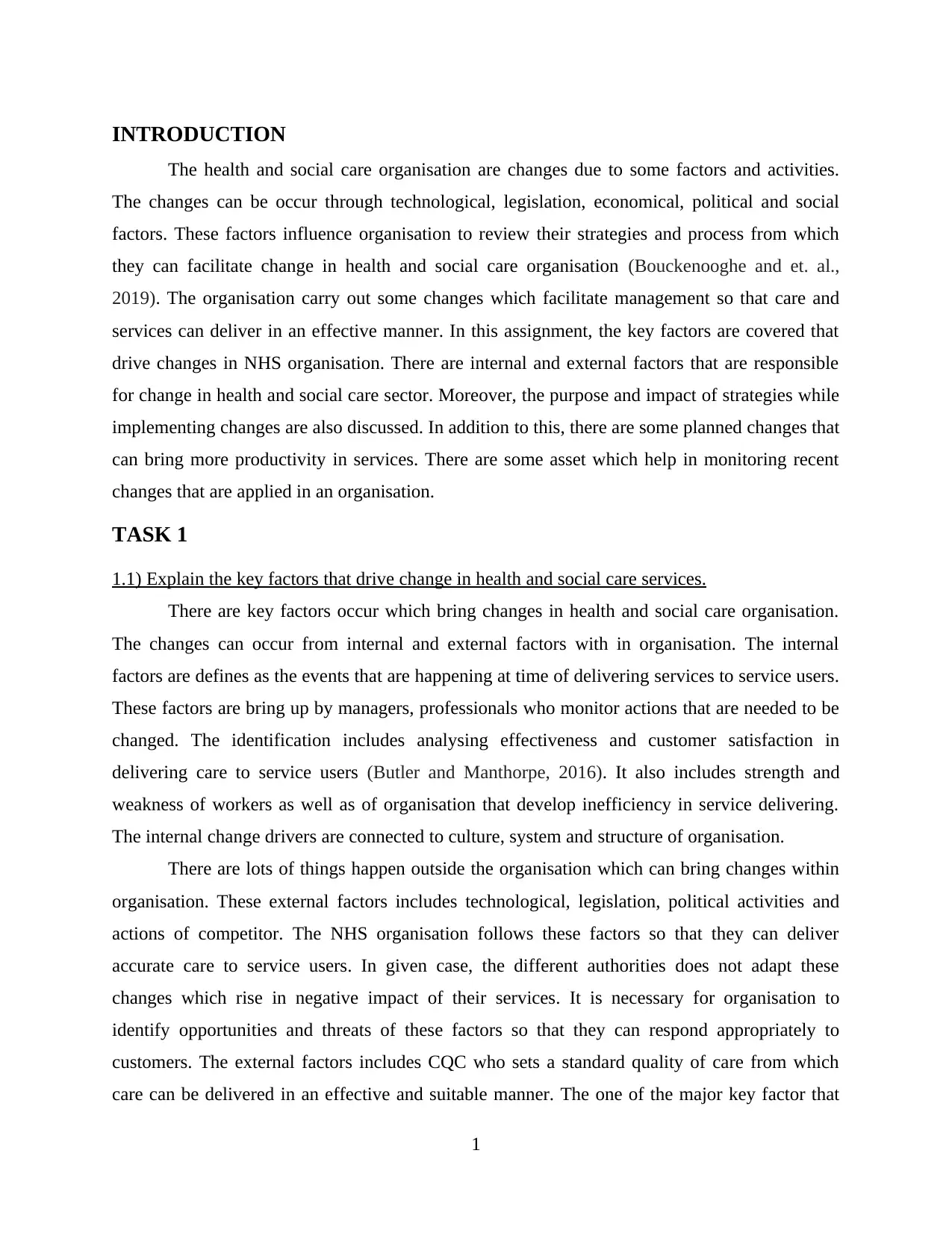
INTRODUCTION
The health and social care organisation are changes due to some factors and activities.
The changes can be occur through technological, legislation, economical, political and social
factors. These factors influence organisation to review their strategies and process from which
they can facilitate change in health and social care organisation (Bouckenooghe and et. al.,
2019). The organisation carry out some changes which facilitate management so that care and
services can deliver in an effective manner. In this assignment, the key factors are covered that
drive changes in NHS organisation. There are internal and external factors that are responsible
for change in health and social care sector. Moreover, the purpose and impact of strategies while
implementing changes are also discussed. In addition to this, there are some planned changes that
can bring more productivity in services. There are some asset which help in monitoring recent
changes that are applied in an organisation.
TASK 1
1.1) Explain the key factors that drive change in health and social care services.
There are key factors occur which bring changes in health and social care organisation.
The changes can occur from internal and external factors with in organisation. The internal
factors are defines as the events that are happening at time of delivering services to service users.
These factors are bring up by managers, professionals who monitor actions that are needed to be
changed. The identification includes analysing effectiveness and customer satisfaction in
delivering care to service users (Butler and Manthorpe, 2016). It also includes strength and
weakness of workers as well as of organisation that develop inefficiency in service delivering.
The internal change drivers are connected to culture, system and structure of organisation.
There are lots of things happen outside the organisation which can bring changes within
organisation. These external factors includes technological, legislation, political activities and
actions of competitor. The NHS organisation follows these factors so that they can deliver
accurate care to service users. In given case, the different authorities does not adapt these
changes which rise in negative impact of their services. It is necessary for organisation to
identify opportunities and threats of these factors so that they can respond appropriately to
customers. The external factors includes CQC who sets a standard quality of care from which
care can be delivered in an effective and suitable manner. The one of the major key factor that
1
The health and social care organisation are changes due to some factors and activities.
The changes can be occur through technological, legislation, economical, political and social
factors. These factors influence organisation to review their strategies and process from which
they can facilitate change in health and social care organisation (Bouckenooghe and et. al.,
2019). The organisation carry out some changes which facilitate management so that care and
services can deliver in an effective manner. In this assignment, the key factors are covered that
drive changes in NHS organisation. There are internal and external factors that are responsible
for change in health and social care sector. Moreover, the purpose and impact of strategies while
implementing changes are also discussed. In addition to this, there are some planned changes that
can bring more productivity in services. There are some asset which help in monitoring recent
changes that are applied in an organisation.
TASK 1
1.1) Explain the key factors that drive change in health and social care services.
There are key factors occur which bring changes in health and social care organisation.
The changes can occur from internal and external factors with in organisation. The internal
factors are defines as the events that are happening at time of delivering services to service users.
These factors are bring up by managers, professionals who monitor actions that are needed to be
changed. The identification includes analysing effectiveness and customer satisfaction in
delivering care to service users (Butler and Manthorpe, 2016). It also includes strength and
weakness of workers as well as of organisation that develop inefficiency in service delivering.
The internal change drivers are connected to culture, system and structure of organisation.
There are lots of things happen outside the organisation which can bring changes within
organisation. These external factors includes technological, legislation, political activities and
actions of competitor. The NHS organisation follows these factors so that they can deliver
accurate care to service users. In given case, the different authorities does not adapt these
changes which rise in negative impact of their services. It is necessary for organisation to
identify opportunities and threats of these factors so that they can respond appropriately to
customers. The external factors includes CQC who sets a standard quality of care from which
care can be delivered in an effective and suitable manner. The one of the major key factor that
1
⊘ This is a preview!⊘
Do you want full access?
Subscribe today to unlock all pages.

Trusted by 1+ million students worldwide
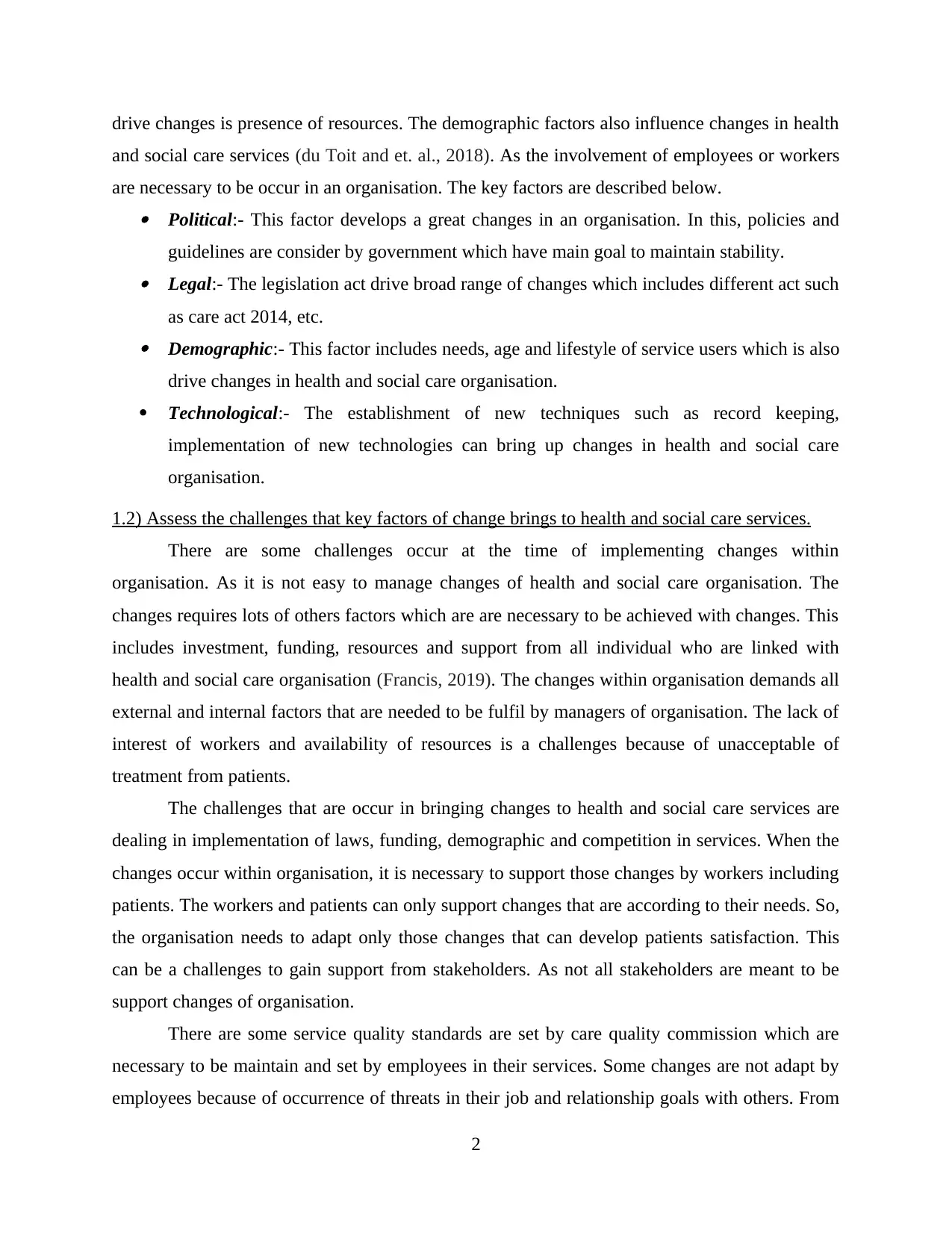
drive changes is presence of resources. The demographic factors also influence changes in health
and social care services (du Toit and et. al., 2018). As the involvement of employees or workers
are necessary to be occur in an organisation. The key factors are described below. Political:- This factor develops a great changes in an organisation. In this, policies and
guidelines are consider by government which have main goal to maintain stability. Legal:- The legislation act drive broad range of changes which includes different act such
as care act 2014, etc. Demographic:- This factor includes needs, age and lifestyle of service users which is also
drive changes in health and social care organisation.
Technological:- The establishment of new techniques such as record keeping,
implementation of new technologies can bring up changes in health and social care
organisation.
1.2) Assess the challenges that key factors of change brings to health and social care services.
There are some challenges occur at the time of implementing changes within
organisation. As it is not easy to manage changes of health and social care organisation. The
changes requires lots of others factors which are are necessary to be achieved with changes. This
includes investment, funding, resources and support from all individual who are linked with
health and social care organisation (Francis, 2019). The changes within organisation demands all
external and internal factors that are needed to be fulfil by managers of organisation. The lack of
interest of workers and availability of resources is a challenges because of unacceptable of
treatment from patients.
The challenges that are occur in bringing changes to health and social care services are
dealing in implementation of laws, funding, demographic and competition in services. When the
changes occur within organisation, it is necessary to support those changes by workers including
patients. The workers and patients can only support changes that are according to their needs. So,
the organisation needs to adapt only those changes that can develop patients satisfaction. This
can be a challenges to gain support from stakeholders. As not all stakeholders are meant to be
support changes of organisation.
There are some service quality standards are set by care quality commission which are
necessary to be maintain and set by employees in their services. Some changes are not adapt by
employees because of occurrence of threats in their job and relationship goals with others. From
2
and social care services (du Toit and et. al., 2018). As the involvement of employees or workers
are necessary to be occur in an organisation. The key factors are described below. Political:- This factor develops a great changes in an organisation. In this, policies and
guidelines are consider by government which have main goal to maintain stability. Legal:- The legislation act drive broad range of changes which includes different act such
as care act 2014, etc. Demographic:- This factor includes needs, age and lifestyle of service users which is also
drive changes in health and social care organisation.
Technological:- The establishment of new techniques such as record keeping,
implementation of new technologies can bring up changes in health and social care
organisation.
1.2) Assess the challenges that key factors of change brings to health and social care services.
There are some challenges occur at the time of implementing changes within
organisation. As it is not easy to manage changes of health and social care organisation. The
changes requires lots of others factors which are are necessary to be achieved with changes. This
includes investment, funding, resources and support from all individual who are linked with
health and social care organisation (Francis, 2019). The changes within organisation demands all
external and internal factors that are needed to be fulfil by managers of organisation. The lack of
interest of workers and availability of resources is a challenges because of unacceptable of
treatment from patients.
The challenges that are occur in bringing changes to health and social care services are
dealing in implementation of laws, funding, demographic and competition in services. When the
changes occur within organisation, it is necessary to support those changes by workers including
patients. The workers and patients can only support changes that are according to their needs. So,
the organisation needs to adapt only those changes that can develop patients satisfaction. This
can be a challenges to gain support from stakeholders. As not all stakeholders are meant to be
support changes of organisation.
There are some service quality standards are set by care quality commission which are
necessary to be maintain and set by employees in their services. Some changes are not adapt by
employees because of occurrence of threats in their job and relationship goals with others. From
2
Paraphrase This Document
Need a fresh take? Get an instant paraphrase of this document with our AI Paraphraser
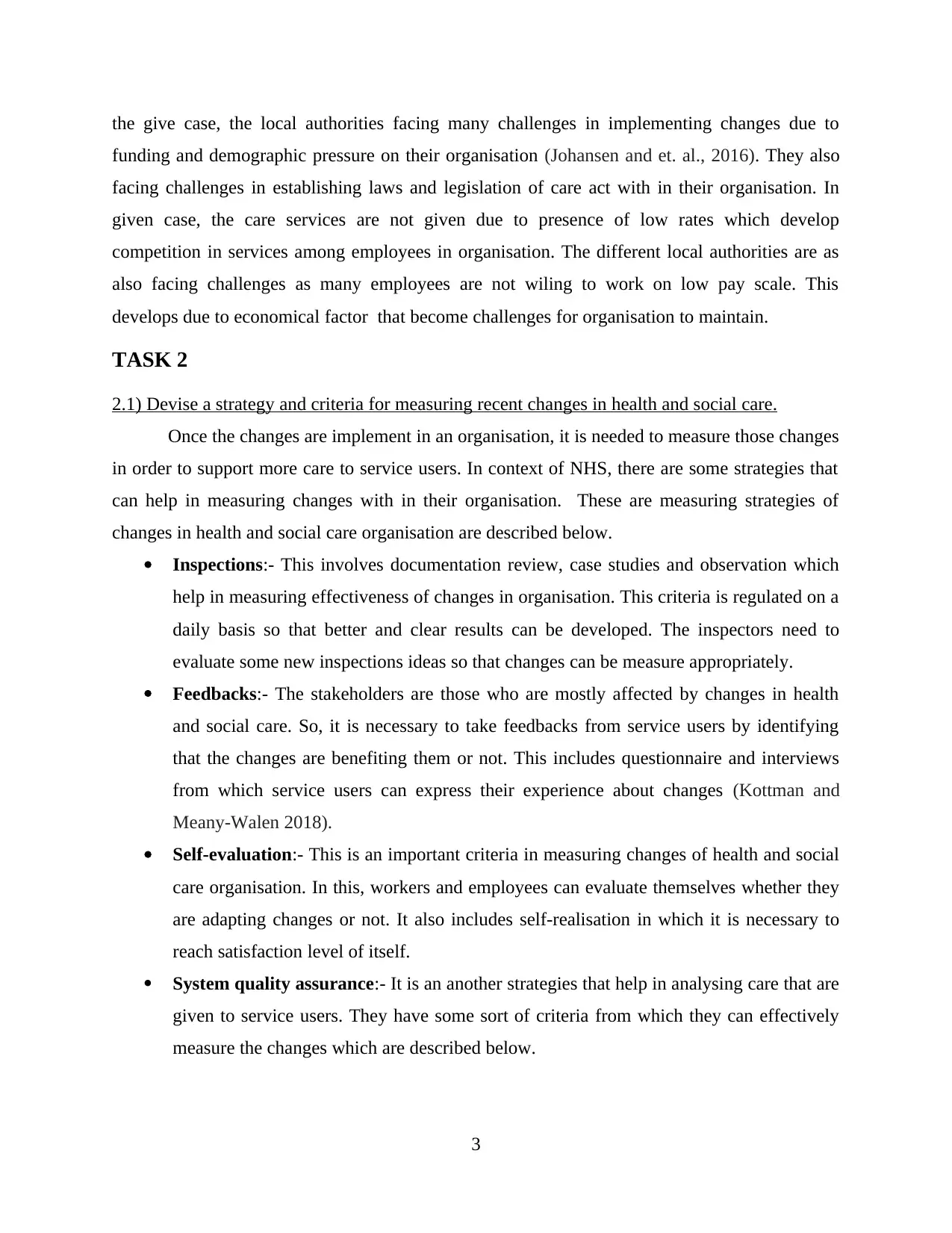
the give case, the local authorities facing many challenges in implementing changes due to
funding and demographic pressure on their organisation (Johansen and et. al., 2016). They also
facing challenges in establishing laws and legislation of care act with in their organisation. In
given case, the care services are not given due to presence of low rates which develop
competition in services among employees in organisation. The different local authorities are as
also facing challenges as many employees are not wiling to work on low pay scale. This
develops due to economical factor that become challenges for organisation to maintain.
TASK 2
2.1) Devise a strategy and criteria for measuring recent changes in health and social care.
Once the changes are implement in an organisation, it is needed to measure those changes
in order to support more care to service users. In context of NHS, there are some strategies that
can help in measuring changes with in their organisation. These are measuring strategies of
changes in health and social care organisation are described below.
Inspections:- This involves documentation review, case studies and observation which
help in measuring effectiveness of changes in organisation. This criteria is regulated on a
daily basis so that better and clear results can be developed. The inspectors need to
evaluate some new inspections ideas so that changes can be measure appropriately.
Feedbacks:- The stakeholders are those who are mostly affected by changes in health
and social care. So, it is necessary to take feedbacks from service users by identifying
that the changes are benefiting them or not. This includes questionnaire and interviews
from which service users can express their experience about changes (Kottman and
Meany-Walen 2018).
Self-evaluation:- This is an important criteria in measuring changes of health and social
care organisation. In this, workers and employees can evaluate themselves whether they
are adapting changes or not. It also includes self-realisation in which it is necessary to
reach satisfaction level of itself.
System quality assurance:- It is an another strategies that help in analysing care that are
given to service users. They have some sort of criteria from which they can effectively
measure the changes which are described below.
3
funding and demographic pressure on their organisation (Johansen and et. al., 2016). They also
facing challenges in establishing laws and legislation of care act with in their organisation. In
given case, the care services are not given due to presence of low rates which develop
competition in services among employees in organisation. The different local authorities are as
also facing challenges as many employees are not wiling to work on low pay scale. This
develops due to economical factor that become challenges for organisation to maintain.
TASK 2
2.1) Devise a strategy and criteria for measuring recent changes in health and social care.
Once the changes are implement in an organisation, it is needed to measure those changes
in order to support more care to service users. In context of NHS, there are some strategies that
can help in measuring changes with in their organisation. These are measuring strategies of
changes in health and social care organisation are described below.
Inspections:- This involves documentation review, case studies and observation which
help in measuring effectiveness of changes in organisation. This criteria is regulated on a
daily basis so that better and clear results can be developed. The inspectors need to
evaluate some new inspections ideas so that changes can be measure appropriately.
Feedbacks:- The stakeholders are those who are mostly affected by changes in health
and social care. So, it is necessary to take feedbacks from service users by identifying
that the changes are benefiting them or not. This includes questionnaire and interviews
from which service users can express their experience about changes (Kottman and
Meany-Walen 2018).
Self-evaluation:- This is an important criteria in measuring changes of health and social
care organisation. In this, workers and employees can evaluate themselves whether they
are adapting changes or not. It also includes self-realisation in which it is necessary to
reach satisfaction level of itself.
System quality assurance:- It is an another strategies that help in analysing care that are
given to service users. They have some sort of criteria from which they can effectively
measure the changes which are described below.
3
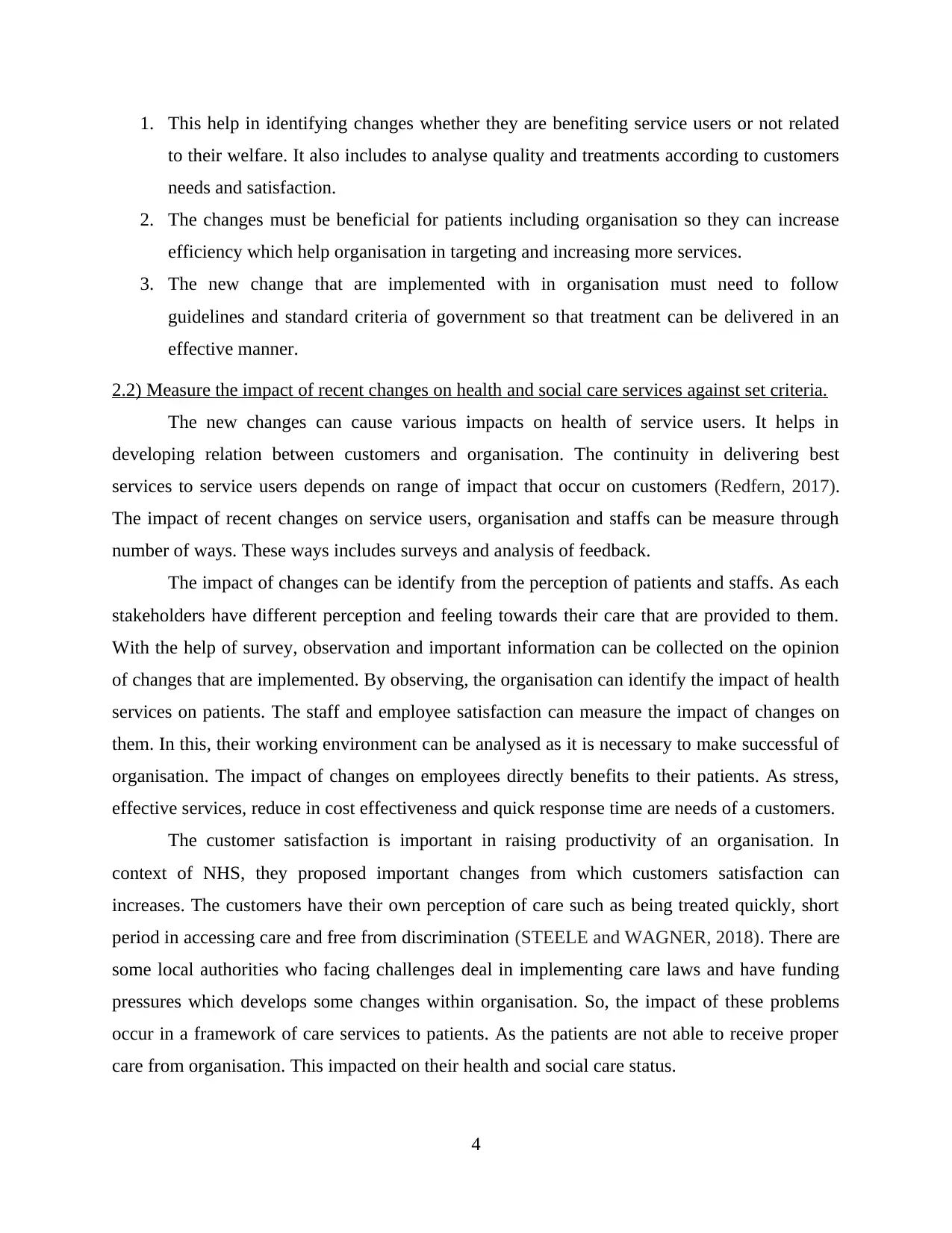
1. This help in identifying changes whether they are benefiting service users or not related
to their welfare. It also includes to analyse quality and treatments according to customers
needs and satisfaction.
2. The changes must be beneficial for patients including organisation so they can increase
efficiency which help organisation in targeting and increasing more services.
3. The new change that are implemented with in organisation must need to follow
guidelines and standard criteria of government so that treatment can be delivered in an
effective manner.
2.2) Measure the impact of recent changes on health and social care services against set criteria.
The new changes can cause various impacts on health of service users. It helps in
developing relation between customers and organisation. The continuity in delivering best
services to service users depends on range of impact that occur on customers (Redfern, 2017).
The impact of recent changes on service users, organisation and staffs can be measure through
number of ways. These ways includes surveys and analysis of feedback.
The impact of changes can be identify from the perception of patients and staffs. As each
stakeholders have different perception and feeling towards their care that are provided to them.
With the help of survey, observation and important information can be collected on the opinion
of changes that are implemented. By observing, the organisation can identify the impact of health
services on patients. The staff and employee satisfaction can measure the impact of changes on
them. In this, their working environment can be analysed as it is necessary to make successful of
organisation. The impact of changes on employees directly benefits to their patients. As stress,
effective services, reduce in cost effectiveness and quick response time are needs of a customers.
The customer satisfaction is important in raising productivity of an organisation. In
context of NHS, they proposed important changes from which customers satisfaction can
increases. The customers have their own perception of care such as being treated quickly, short
period in accessing care and free from discrimination (STEELE and WAGNER, 2018). There are
some local authorities who facing challenges deal in implementing care laws and have funding
pressures which develops some changes within organisation. So, the impact of these problems
occur in a framework of care services to patients. As the patients are not able to receive proper
care from organisation. This impacted on their health and social care status.
4
to their welfare. It also includes to analyse quality and treatments according to customers
needs and satisfaction.
2. The changes must be beneficial for patients including organisation so they can increase
efficiency which help organisation in targeting and increasing more services.
3. The new change that are implemented with in organisation must need to follow
guidelines and standard criteria of government so that treatment can be delivered in an
effective manner.
2.2) Measure the impact of recent changes on health and social care services against set criteria.
The new changes can cause various impacts on health of service users. It helps in
developing relation between customers and organisation. The continuity in delivering best
services to service users depends on range of impact that occur on customers (Redfern, 2017).
The impact of recent changes on service users, organisation and staffs can be measure through
number of ways. These ways includes surveys and analysis of feedback.
The impact of changes can be identify from the perception of patients and staffs. As each
stakeholders have different perception and feeling towards their care that are provided to them.
With the help of survey, observation and important information can be collected on the opinion
of changes that are implemented. By observing, the organisation can identify the impact of health
services on patients. The staff and employee satisfaction can measure the impact of changes on
them. In this, their working environment can be analysed as it is necessary to make successful of
organisation. The impact of changes on employees directly benefits to their patients. As stress,
effective services, reduce in cost effectiveness and quick response time are needs of a customers.
The customer satisfaction is important in raising productivity of an organisation. In
context of NHS, they proposed important changes from which customers satisfaction can
increases. The customers have their own perception of care such as being treated quickly, short
period in accessing care and free from discrimination (STEELE and WAGNER, 2018). There are
some local authorities who facing challenges deal in implementing care laws and have funding
pressures which develops some changes within organisation. So, the impact of these problems
occur in a framework of care services to patients. As the patients are not able to receive proper
care from organisation. This impacted on their health and social care status.
4
⊘ This is a preview!⊘
Do you want full access?
Subscribe today to unlock all pages.

Trusted by 1+ million students worldwide
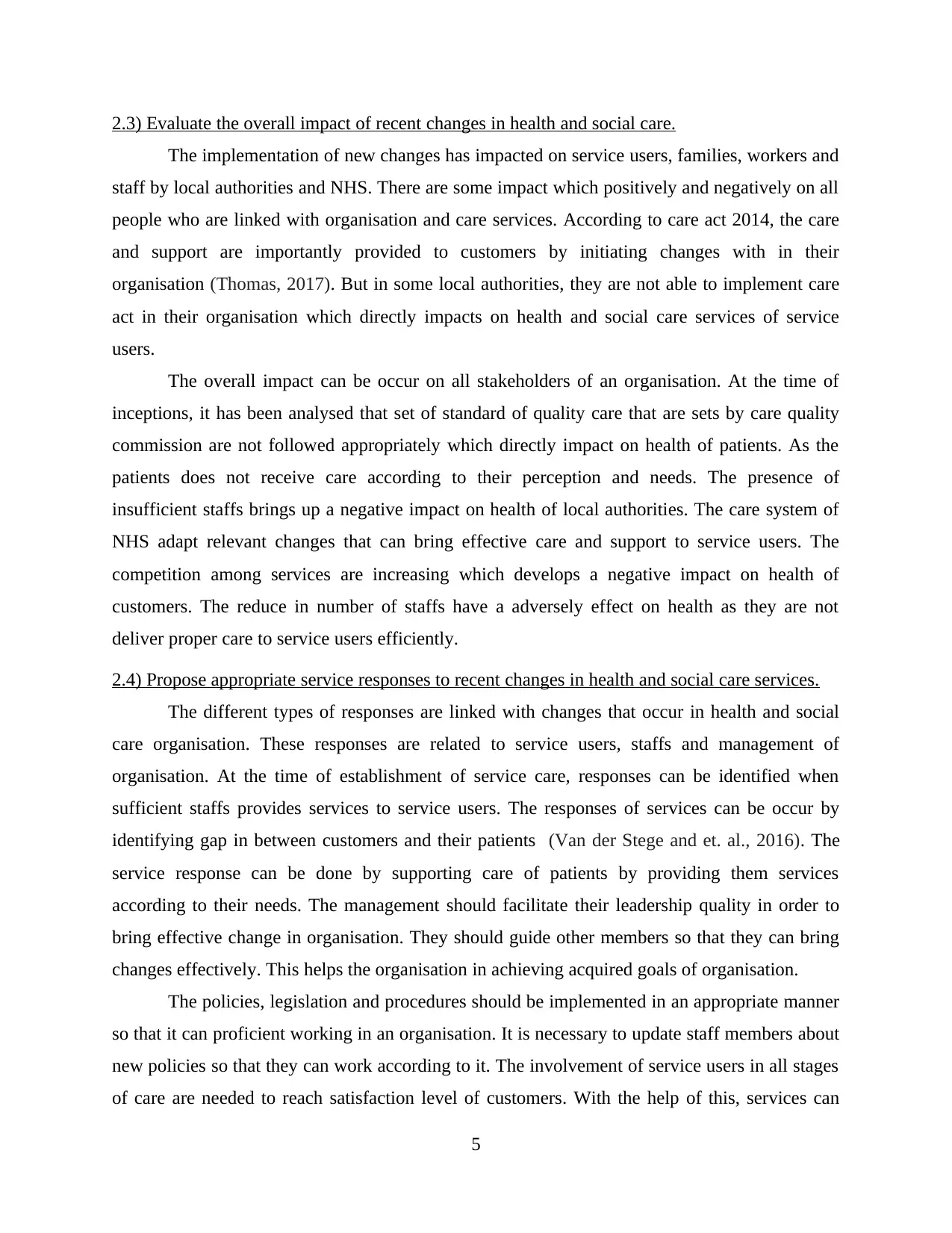
2.3) Evaluate the overall impact of recent changes in health and social care.
The implementation of new changes has impacted on service users, families, workers and
staff by local authorities and NHS. There are some impact which positively and negatively on all
people who are linked with organisation and care services. According to care act 2014, the care
and support are importantly provided to customers by initiating changes with in their
organisation (Thomas, 2017). But in some local authorities, they are not able to implement care
act in their organisation which directly impacts on health and social care services of service
users.
The overall impact can be occur on all stakeholders of an organisation. At the time of
inceptions, it has been analysed that set of standard of quality care that are sets by care quality
commission are not followed appropriately which directly impact on health of patients. As the
patients does not receive care according to their perception and needs. The presence of
insufficient staffs brings up a negative impact on health of local authorities. The care system of
NHS adapt relevant changes that can bring effective care and support to service users. The
competition among services are increasing which develops a negative impact on health of
customers. The reduce in number of staffs have a adversely effect on health as they are not
deliver proper care to service users efficiently.
2.4) Propose appropriate service responses to recent changes in health and social care services.
The different types of responses are linked with changes that occur in health and social
care organisation. These responses are related to service users, staffs and management of
organisation. At the time of establishment of service care, responses can be identified when
sufficient staffs provides services to service users. The responses of services can be occur by
identifying gap in between customers and their patients (Van der Stege and et. al., 2016). The
service response can be done by supporting care of patients by providing them services
according to their needs. The management should facilitate their leadership quality in order to
bring effective change in organisation. They should guide other members so that they can bring
changes effectively. This helps the organisation in achieving acquired goals of organisation.
The policies, legislation and procedures should be implemented in an appropriate manner
so that it can proficient working in an organisation. It is necessary to update staff members about
new policies so that they can work according to it. The involvement of service users in all stages
of care are needed to reach satisfaction level of customers. With the help of this, services can
5
The implementation of new changes has impacted on service users, families, workers and
staff by local authorities and NHS. There are some impact which positively and negatively on all
people who are linked with organisation and care services. According to care act 2014, the care
and support are importantly provided to customers by initiating changes with in their
organisation (Thomas, 2017). But in some local authorities, they are not able to implement care
act in their organisation which directly impacts on health and social care services of service
users.
The overall impact can be occur on all stakeholders of an organisation. At the time of
inceptions, it has been analysed that set of standard of quality care that are sets by care quality
commission are not followed appropriately which directly impact on health of patients. As the
patients does not receive care according to their perception and needs. The presence of
insufficient staffs brings up a negative impact on health of local authorities. The care system of
NHS adapt relevant changes that can bring effective care and support to service users. The
competition among services are increasing which develops a negative impact on health of
customers. The reduce in number of staffs have a adversely effect on health as they are not
deliver proper care to service users efficiently.
2.4) Propose appropriate service responses to recent changes in health and social care services.
The different types of responses are linked with changes that occur in health and social
care organisation. These responses are related to service users, staffs and management of
organisation. At the time of establishment of service care, responses can be identified when
sufficient staffs provides services to service users. The responses of services can be occur by
identifying gap in between customers and their patients (Van der Stege and et. al., 2016). The
service response can be done by supporting care of patients by providing them services
according to their needs. The management should facilitate their leadership quality in order to
bring effective change in organisation. They should guide other members so that they can bring
changes effectively. This helps the organisation in achieving acquired goals of organisation.
The policies, legislation and procedures should be implemented in an appropriate manner
so that it can proficient working in an organisation. It is necessary to update staff members about
new policies so that they can work according to it. The involvement of service users in all stages
of care are needed to reach satisfaction level of customers. With the help of this, services can
5
Paraphrase This Document
Need a fresh take? Get an instant paraphrase of this document with our AI Paraphraser
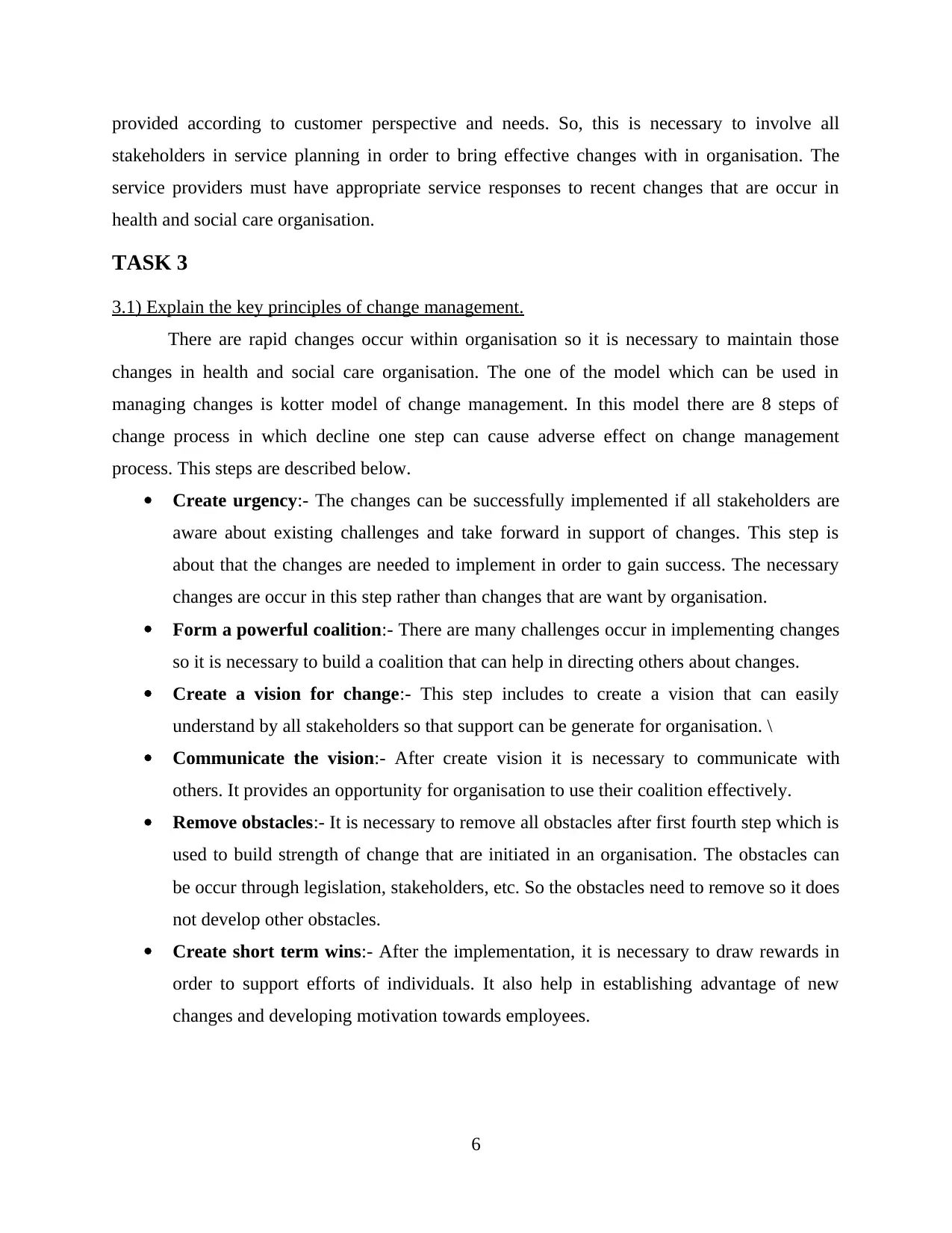
provided according to customer perspective and needs. So, this is necessary to involve all
stakeholders in service planning in order to bring effective changes with in organisation. The
service providers must have appropriate service responses to recent changes that are occur in
health and social care organisation.
TASK 3
3.1) Explain the key principles of change management.
There are rapid changes occur within organisation so it is necessary to maintain those
changes in health and social care organisation. The one of the model which can be used in
managing changes is kotter model of change management. In this model there are 8 steps of
change process in which decline one step can cause adverse effect on change management
process. This steps are described below.
Create urgency:- The changes can be successfully implemented if all stakeholders are
aware about existing challenges and take forward in support of changes. This step is
about that the changes are needed to implement in order to gain success. The necessary
changes are occur in this step rather than changes that are want by organisation.
Form a powerful coalition:- There are many challenges occur in implementing changes
so it is necessary to build a coalition that can help in directing others about changes.
Create a vision for change:- This step includes to create a vision that can easily
understand by all stakeholders so that support can be generate for organisation. \
Communicate the vision:- After create vision it is necessary to communicate with
others. It provides an opportunity for organisation to use their coalition effectively.
Remove obstacles:- It is necessary to remove all obstacles after first fourth step which is
used to build strength of change that are initiated in an organisation. The obstacles can
be occur through legislation, stakeholders, etc. So the obstacles need to remove so it does
not develop other obstacles.
Create short term wins:- After the implementation, it is necessary to draw rewards in
order to support efforts of individuals. It also help in establishing advantage of new
changes and developing motivation towards employees.
6
stakeholders in service planning in order to bring effective changes with in organisation. The
service providers must have appropriate service responses to recent changes that are occur in
health and social care organisation.
TASK 3
3.1) Explain the key principles of change management.
There are rapid changes occur within organisation so it is necessary to maintain those
changes in health and social care organisation. The one of the model which can be used in
managing changes is kotter model of change management. In this model there are 8 steps of
change process in which decline one step can cause adverse effect on change management
process. This steps are described below.
Create urgency:- The changes can be successfully implemented if all stakeholders are
aware about existing challenges and take forward in support of changes. This step is
about that the changes are needed to implement in order to gain success. The necessary
changes are occur in this step rather than changes that are want by organisation.
Form a powerful coalition:- There are many challenges occur in implementing changes
so it is necessary to build a coalition that can help in directing others about changes.
Create a vision for change:- This step includes to create a vision that can easily
understand by all stakeholders so that support can be generate for organisation. \
Communicate the vision:- After create vision it is necessary to communicate with
others. It provides an opportunity for organisation to use their coalition effectively.
Remove obstacles:- It is necessary to remove all obstacles after first fourth step which is
used to build strength of change that are initiated in an organisation. The obstacles can
be occur through legislation, stakeholders, etc. So the obstacles need to remove so it does
not develop other obstacles.
Create short term wins:- After the implementation, it is necessary to draw rewards in
order to support efforts of individuals. It also help in establishing advantage of new
changes and developing motivation towards employees.
6
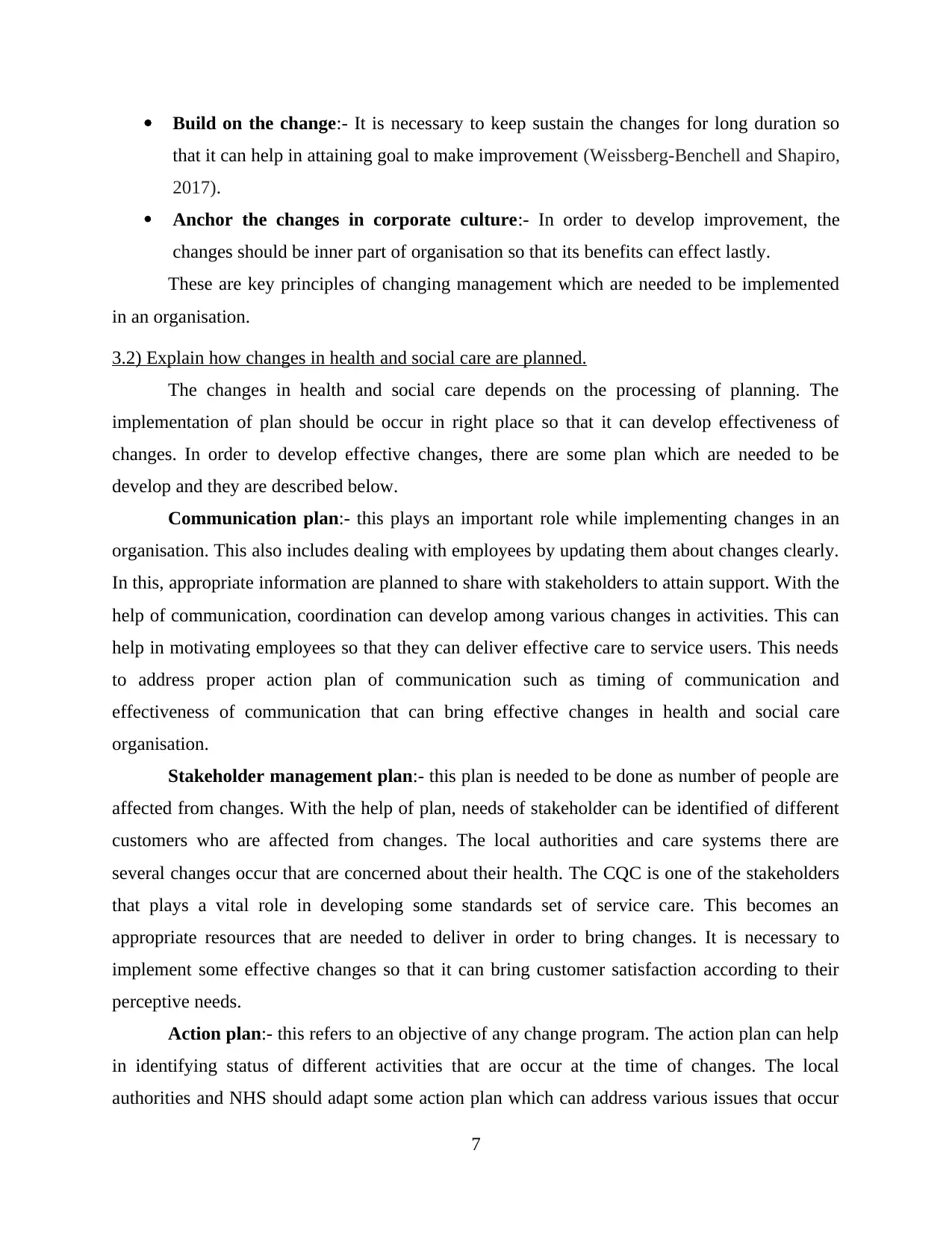
Build on the change:- It is necessary to keep sustain the changes for long duration so
that it can help in attaining goal to make improvement (Weissberg-Benchell and Shapiro,
2017).
Anchor the changes in corporate culture:- In order to develop improvement, the
changes should be inner part of organisation so that its benefits can effect lastly.
These are key principles of changing management which are needed to be implemented
in an organisation.
3.2) Explain how changes in health and social care are planned.
The changes in health and social care depends on the processing of planning. The
implementation of plan should be occur in right place so that it can develop effectiveness of
changes. In order to develop effective changes, there are some plan which are needed to be
develop and they are described below.
Communication plan:- this plays an important role while implementing changes in an
organisation. This also includes dealing with employees by updating them about changes clearly.
In this, appropriate information are planned to share with stakeholders to attain support. With the
help of communication, coordination can develop among various changes in activities. This can
help in motivating employees so that they can deliver effective care to service users. This needs
to address proper action plan of communication such as timing of communication and
effectiveness of communication that can bring effective changes in health and social care
organisation.
Stakeholder management plan:- this plan is needed to be done as number of people are
affected from changes. With the help of plan, needs of stakeholder can be identified of different
customers who are affected from changes. The local authorities and care systems there are
several changes occur that are concerned about their health. The CQC is one of the stakeholders
that plays a vital role in developing some standards set of service care. This becomes an
appropriate resources that are needed to deliver in order to bring changes. It is necessary to
implement some effective changes so that it can bring customer satisfaction according to their
perceptive needs.
Action plan:- this refers to an objective of any change program. The action plan can help
in identifying status of different activities that are occur at the time of changes. The local
authorities and NHS should adapt some action plan which can address various issues that occur
7
that it can help in attaining goal to make improvement (Weissberg-Benchell and Shapiro,
2017).
Anchor the changes in corporate culture:- In order to develop improvement, the
changes should be inner part of organisation so that its benefits can effect lastly.
These are key principles of changing management which are needed to be implemented
in an organisation.
3.2) Explain how changes in health and social care are planned.
The changes in health and social care depends on the processing of planning. The
implementation of plan should be occur in right place so that it can develop effectiveness of
changes. In order to develop effective changes, there are some plan which are needed to be
develop and they are described below.
Communication plan:- this plays an important role while implementing changes in an
organisation. This also includes dealing with employees by updating them about changes clearly.
In this, appropriate information are planned to share with stakeholders to attain support. With the
help of communication, coordination can develop among various changes in activities. This can
help in motivating employees so that they can deliver effective care to service users. This needs
to address proper action plan of communication such as timing of communication and
effectiveness of communication that can bring effective changes in health and social care
organisation.
Stakeholder management plan:- this plan is needed to be done as number of people are
affected from changes. With the help of plan, needs of stakeholder can be identified of different
customers who are affected from changes. The local authorities and care systems there are
several changes occur that are concerned about their health. The CQC is one of the stakeholders
that plays a vital role in developing some standards set of service care. This becomes an
appropriate resources that are needed to deliver in order to bring changes. It is necessary to
implement some effective changes so that it can bring customer satisfaction according to their
perceptive needs.
Action plan:- this refers to an objective of any change program. The action plan can help
in identifying status of different activities that are occur at the time of changes. The local
authorities and NHS should adapt some action plan which can address various issues that occur
7
⊘ This is a preview!⊘
Do you want full access?
Subscribe today to unlock all pages.

Trusted by 1+ million students worldwide
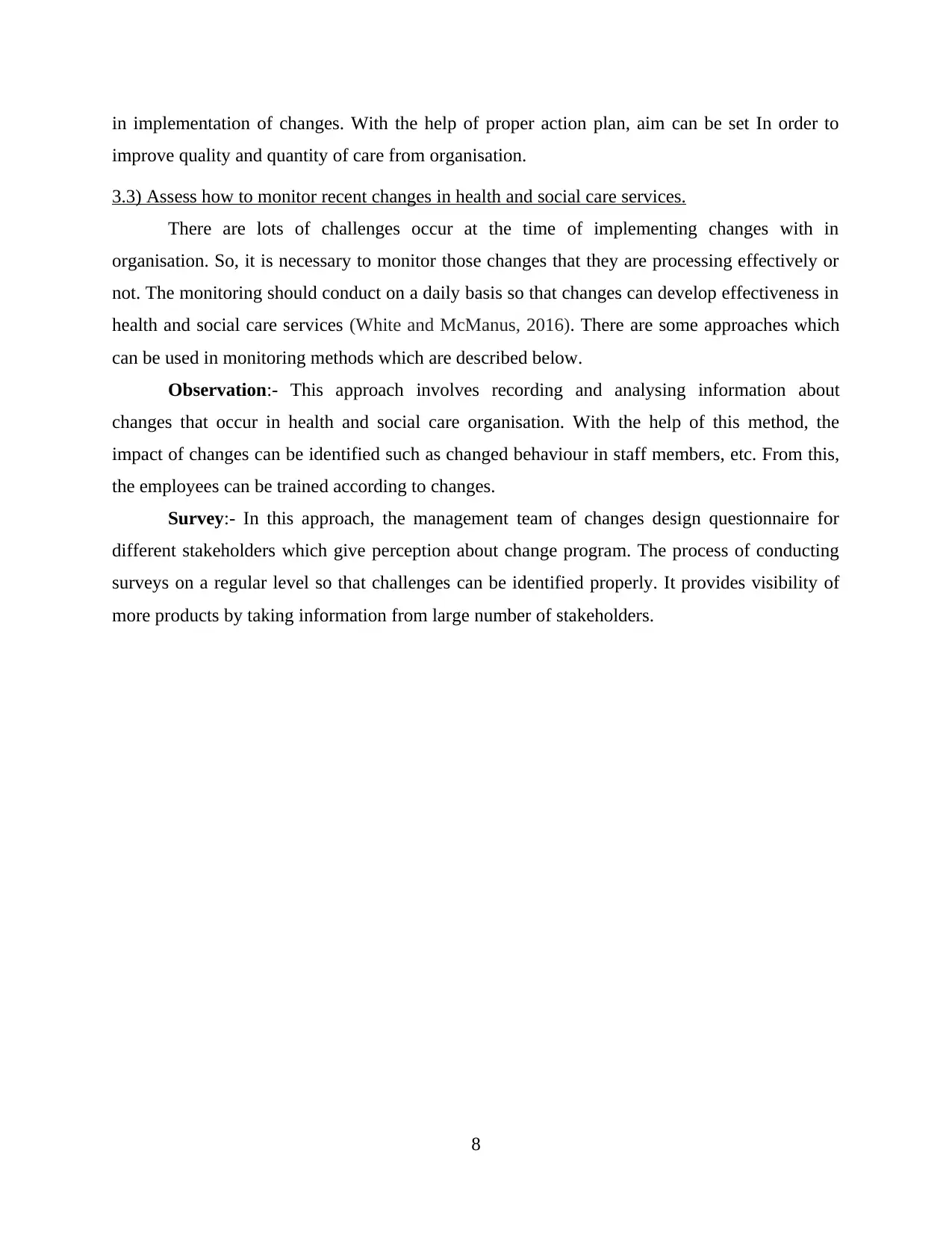
in implementation of changes. With the help of proper action plan, aim can be set In order to
improve quality and quantity of care from organisation.
3.3) Assess how to monitor recent changes in health and social care services.
There are lots of challenges occur at the time of implementing changes with in
organisation. So, it is necessary to monitor those changes that they are processing effectively or
not. The monitoring should conduct on a daily basis so that changes can develop effectiveness in
health and social care services (White and McManus, 2016). There are some approaches which
can be used in monitoring methods which are described below.
Observation:- This approach involves recording and analysing information about
changes that occur in health and social care organisation. With the help of this method, the
impact of changes can be identified such as changed behaviour in staff members, etc. From this,
the employees can be trained according to changes.
Survey:- In this approach, the management team of changes design questionnaire for
different stakeholders which give perception about change program. The process of conducting
surveys on a regular level so that challenges can be identified properly. It provides visibility of
more products by taking information from large number of stakeholders.
8
improve quality and quantity of care from organisation.
3.3) Assess how to monitor recent changes in health and social care services.
There are lots of challenges occur at the time of implementing changes with in
organisation. So, it is necessary to monitor those changes that they are processing effectively or
not. The monitoring should conduct on a daily basis so that changes can develop effectiveness in
health and social care services (White and McManus, 2016). There are some approaches which
can be used in monitoring methods which are described below.
Observation:- This approach involves recording and analysing information about
changes that occur in health and social care organisation. With the help of this method, the
impact of changes can be identified such as changed behaviour in staff members, etc. From this,
the employees can be trained according to changes.
Survey:- In this approach, the management team of changes design questionnaire for
different stakeholders which give perception about change program. The process of conducting
surveys on a regular level so that challenges can be identified properly. It provides visibility of
more products by taking information from large number of stakeholders.
8
Paraphrase This Document
Need a fresh take? Get an instant paraphrase of this document with our AI Paraphraser
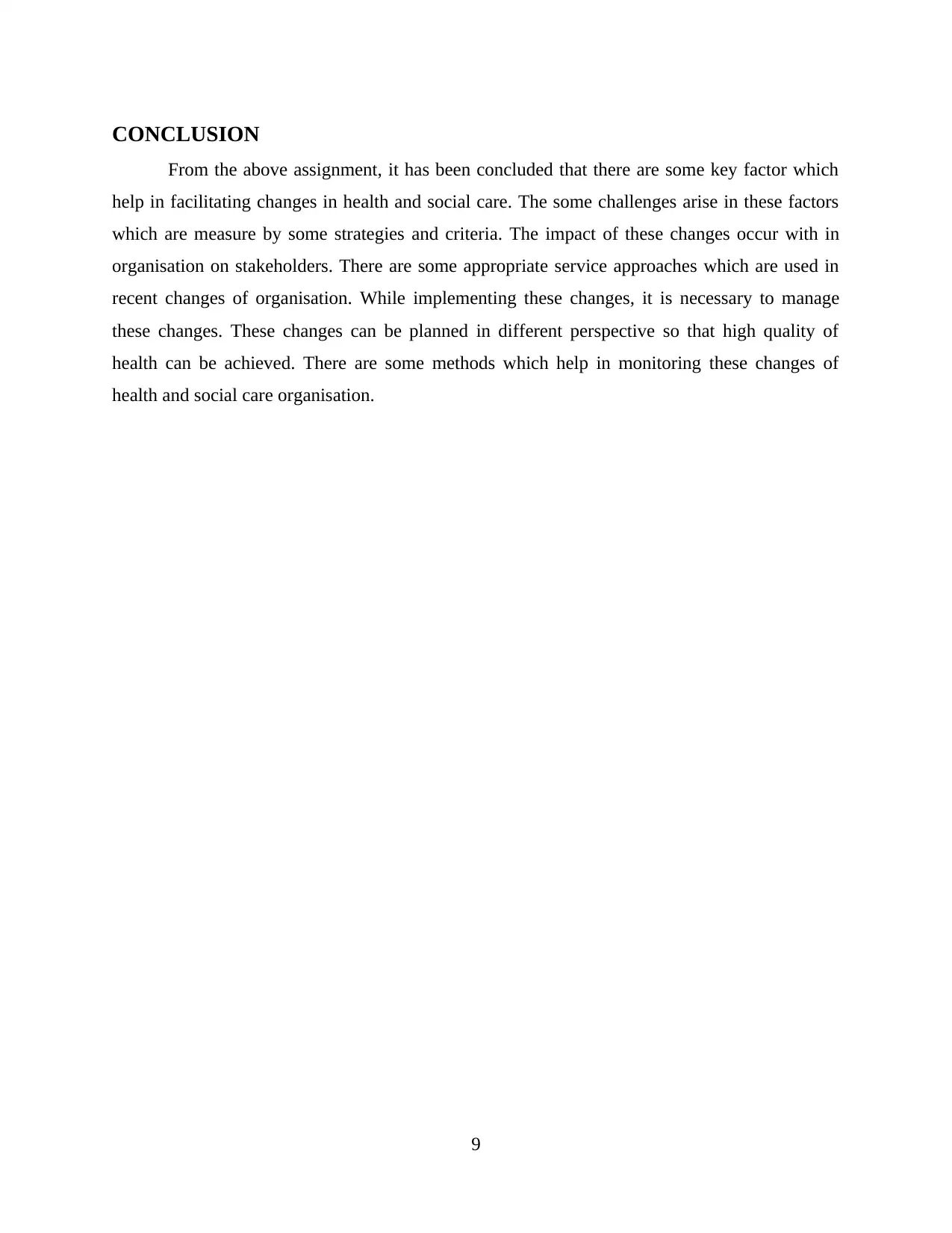
CONCLUSION
From the above assignment, it has been concluded that there are some key factor which
help in facilitating changes in health and social care. The some challenges arise in these factors
which are measure by some strategies and criteria. The impact of these changes occur with in
organisation on stakeholders. There are some appropriate service approaches which are used in
recent changes of organisation. While implementing these changes, it is necessary to manage
these changes. These changes can be planned in different perspective so that high quality of
health can be achieved. There are some methods which help in monitoring these changes of
health and social care organisation.
9
From the above assignment, it has been concluded that there are some key factor which
help in facilitating changes in health and social care. The some challenges arise in these factors
which are measure by some strategies and criteria. The impact of these changes occur with in
organisation on stakeholders. There are some appropriate service approaches which are used in
recent changes of organisation. While implementing these changes, it is necessary to manage
these changes. These changes can be planned in different perspective so that high quality of
health can be achieved. There are some methods which help in monitoring these changes of
health and social care organisation.
9
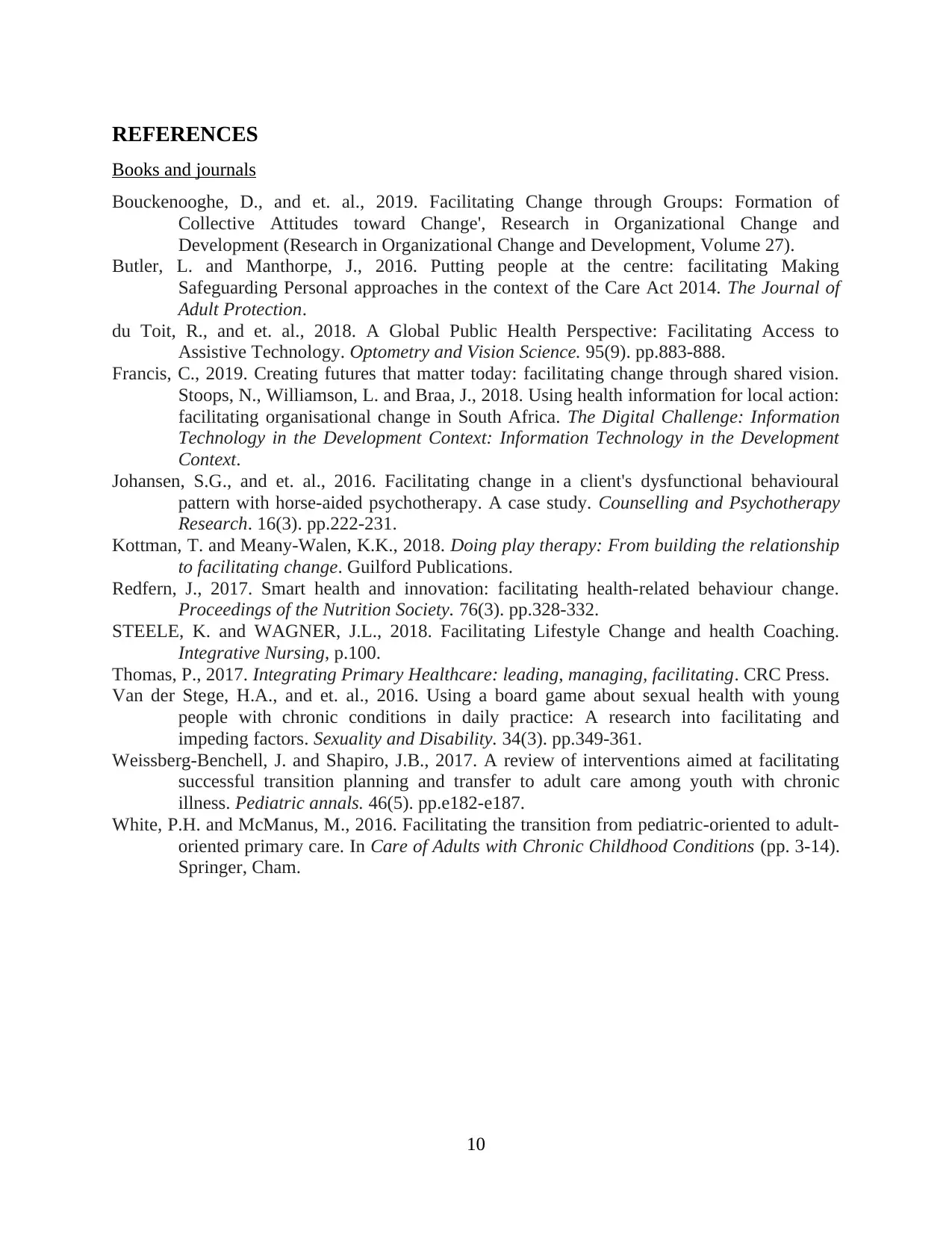
REFERENCES
Books and journals
Bouckenooghe, D., and et. al., 2019. Facilitating Change through Groups: Formation of
Collective Attitudes toward Change', Research in Organizational Change and
Development (Research in Organizational Change and Development, Volume 27).
Butler, L. and Manthorpe, J., 2016. Putting people at the centre: facilitating Making
Safeguarding Personal approaches in the context of the Care Act 2014. The Journal of
Adult Protection.
du Toit, R., and et. al., 2018. A Global Public Health Perspective: Facilitating Access to
Assistive Technology. Optometry and Vision Science. 95(9). pp.883-888.
Francis, C., 2019. Creating futures that matter today: facilitating change through shared vision.
Stoops, N., Williamson, L. and Braa, J., 2018. Using health information for local action:
facilitating organisational change in South Africa. The Digital Challenge: Information
Technology in the Development Context: Information Technology in the Development
Context.
Johansen, S.G., and et. al., 2016. Facilitating change in a client's dysfunctional behavioural
pattern with horse‐aided psychotherapy. A case study. Counselling and Psychotherapy
Research. 16(3). pp.222-231.
Kottman, T. and Meany-Walen, K.K., 2018. Doing play therapy: From building the relationship
to facilitating change. Guilford Publications.
Redfern, J., 2017. Smart health and innovation: facilitating health-related behaviour change.
Proceedings of the Nutrition Society. 76(3). pp.328-332.
STEELE, K. and WAGNER, J.L., 2018. Facilitating Lifestyle Change and health Coaching.
Integrative Nursing, p.100.
Thomas, P., 2017. Integrating Primary Healthcare: leading, managing, facilitating. CRC Press.
Van der Stege, H.A., and et. al., 2016. Using a board game about sexual health with young
people with chronic conditions in daily practice: A research into facilitating and
impeding factors. Sexuality and Disability. 34(3). pp.349-361.
Weissberg-Benchell, J. and Shapiro, J.B., 2017. A review of interventions aimed at facilitating
successful transition planning and transfer to adult care among youth with chronic
illness. Pediatric annals. 46(5). pp.e182-e187.
White, P.H. and McManus, M., 2016. Facilitating the transition from pediatric-oriented to adult-
oriented primary care. In Care of Adults with Chronic Childhood Conditions (pp. 3-14).
Springer, Cham.
10
Books and journals
Bouckenooghe, D., and et. al., 2019. Facilitating Change through Groups: Formation of
Collective Attitudes toward Change', Research in Organizational Change and
Development (Research in Organizational Change and Development, Volume 27).
Butler, L. and Manthorpe, J., 2016. Putting people at the centre: facilitating Making
Safeguarding Personal approaches in the context of the Care Act 2014. The Journal of
Adult Protection.
du Toit, R., and et. al., 2018. A Global Public Health Perspective: Facilitating Access to
Assistive Technology. Optometry and Vision Science. 95(9). pp.883-888.
Francis, C., 2019. Creating futures that matter today: facilitating change through shared vision.
Stoops, N., Williamson, L. and Braa, J., 2018. Using health information for local action:
facilitating organisational change in South Africa. The Digital Challenge: Information
Technology in the Development Context: Information Technology in the Development
Context.
Johansen, S.G., and et. al., 2016. Facilitating change in a client's dysfunctional behavioural
pattern with horse‐aided psychotherapy. A case study. Counselling and Psychotherapy
Research. 16(3). pp.222-231.
Kottman, T. and Meany-Walen, K.K., 2018. Doing play therapy: From building the relationship
to facilitating change. Guilford Publications.
Redfern, J., 2017. Smart health and innovation: facilitating health-related behaviour change.
Proceedings of the Nutrition Society. 76(3). pp.328-332.
STEELE, K. and WAGNER, J.L., 2018. Facilitating Lifestyle Change and health Coaching.
Integrative Nursing, p.100.
Thomas, P., 2017. Integrating Primary Healthcare: leading, managing, facilitating. CRC Press.
Van der Stege, H.A., and et. al., 2016. Using a board game about sexual health with young
people with chronic conditions in daily practice: A research into facilitating and
impeding factors. Sexuality and Disability. 34(3). pp.349-361.
Weissberg-Benchell, J. and Shapiro, J.B., 2017. A review of interventions aimed at facilitating
successful transition planning and transfer to adult care among youth with chronic
illness. Pediatric annals. 46(5). pp.e182-e187.
White, P.H. and McManus, M., 2016. Facilitating the transition from pediatric-oriented to adult-
oriented primary care. In Care of Adults with Chronic Childhood Conditions (pp. 3-14).
Springer, Cham.
10
⊘ This is a preview!⊘
Do you want full access?
Subscribe today to unlock all pages.

Trusted by 1+ million students worldwide
1 out of 12
Related Documents
Your All-in-One AI-Powered Toolkit for Academic Success.
+13062052269
info@desklib.com
Available 24*7 on WhatsApp / Email
![[object Object]](/_next/static/media/star-bottom.7253800d.svg)
Unlock your academic potential
Copyright © 2020–2025 A2Z Services. All Rights Reserved. Developed and managed by ZUCOL.




